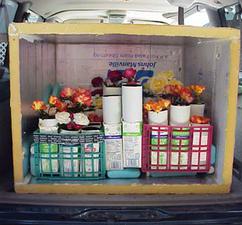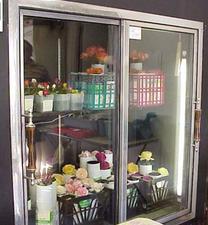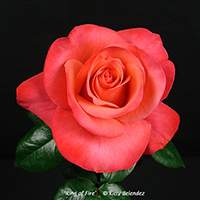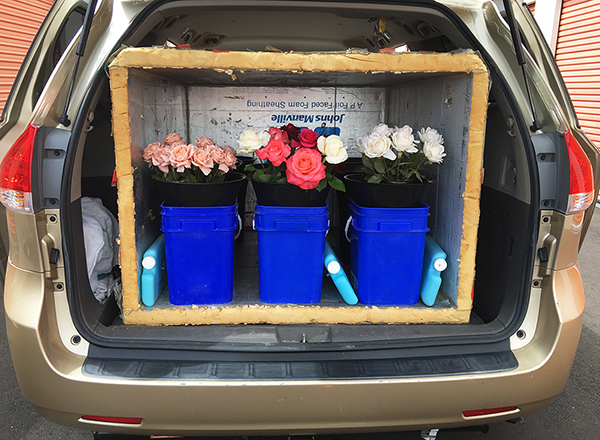A Rose Cooler for Our Minivan
For Transporting Roses to Exhibitions
We use three distinctly different techniques for transporting our roses to shows, depending on the distance that will be traveled: local, short to medium distance, and long distance.
For short to medium distance (usually 100 to 500 miles, and occasionally up to 1,000 miles for a long distance national rose show), the big roses are transported in a custom-made rose cooler, which my husband Bob made to fit in the back of our 1995 Chevy Astro minivan. Years later, we altered our cooler box to fit our 2011 Toyota Sienna minivan.
We have successfully traveled with roses to several national and district rose shows using this special rose cooler.
At Portland in 2001, we won two national trophies: The Dee Bennett Trophy for a collection of 12 Miss Flippins miniature roses, and the Griffith Buck National Trophy for a collection of 3 different shrub roses. Portland was 900 miles driving distance and 18 hours from home.
At San Jose in 2002, we won the Dorothy Stemler national trophy for a bouquet of 8 or more old garden roses. San Jose was 9 hours and 450 miles driving distance from home.
We also used our rose cooler to transport our roses to the May 2002 Pacific Southwest District convention in Irvine, California where we won four district trophies: The Challenge Bowl of OGRs; the Pacific Rose Society Challenge collection of five different floribunda sprays; the Albuquerque Rose Society Challenge with three different shrub specimens; and the Scottsdale Rose Society Challenge with a bouquet of floribunda sprays.
At our April 2003 Pacific Southwest District convention at Mesa, Arizona, we won three District challenge trophies: the Ralph Moore District Challenge Class which required 7 perfect mini blooms in separate vases; the Dee Bennett bouquet of 12 mini roses in one vase with Irresistible; and again the Old Garden Rose Challenge Bowl, a bouquet of old garden roses which featured Anna de Diesbach, Irene Watts, and Yolande d’Aragon. Mesa was 440 miles from home.
At all the conventions, we arrived the evening before the rose show so that we could settle in, locate the show room, and get a good night’s sleep before prepping our roses early the next morning, around 4 a.m.
In 2010 we transported our roses to Tucson where we won the National ARS Traveling Hershey Challenge as well as the Pacific Southwest District McFarland. At the 2012 American Rose Society National Convention in San Ramon, California, Bob and I won the McFarland National Challenge Class and several other trophies. In 2015 we transported our roses to Mesa, AZ, where we won seven District Challenge Classes. All roses had been transported in our special box.
In 2018 we transported our cut roses to the ARS National Rose Show held in San Diego (about 150 miles from home). We used the floral buckets to transport all of our large roses. At this rose show we won 12 Challenge Class trophies, including the National Nicholson (which also won Best of Show), the National McFarland, the National Herb Swim, and many Pacific Southwest District Challenge classes.
A rose cooler will keep your roses fresh for a longer period of time than if transported without refrigeration. This is useful for trips of 100 or more miles and especially when you plan to stay overnight before rose prepping and entries begin.
We made our special rose cooler from six sheets of 2-inch thick Johns-Manville heavy duty insulation material (not cheap Styrofoam), which we glued together to form a box. The finished size is 45"w x 34"h x 49"d. This custom-made rose cooler holds six plastic milk crates plus a dozen or so individual pipes, at least 72 blooms including a few sprays. Three dozen 12-ounce bags, or twelve 48-ounce bottles of frozen gel coolant are strategically placed in several locations inside the cooler.
Of course, with a rose cooler this big, we need to take the back two seats out of the van. However, there is still plenty of space left over for our luggage, grooming kit, camera case, table, chair, and many other supplies.
A rose cooler such as this can be used not only in a minivan, but also a SUV, pickup truck, or station wagon. The sizes need to be adjusted for your own particular vehicle. A smaller version can also be made for a small car. Our first little rose cooler was made to fit the backseat of a 1988 Mustang. Although small, the rose cooler was big enough to carry a dozen roses, one of which won Queen of Show at the district rose show in Phoenix that year.
PIPES IN MILK CRATES
We used milk crates that hold nine half-gallon milk cartons (either plastic or cardboard). The tops of the milk cartons are cut off. 4-inch diameter plastic irrigation pipes are placed inside the milk cartons, containing 8-ounces of Crysal floral preservative mixed with fresh water. (Chrysal is available from www.rosemania.com.) You can purchase 8-foot lengths of irrigation pipe at Home Depot, Lowe’s, or any home improvement store. Cut the pipes (with a saw) to various lengths, whatever you need for your situation. I prefer 9-inch and 18-inch lengths. After sawing the lengths of pipes, it is very important to sand down the edges that have been cut, so they are smooth, to prevent damage to the roses when placing them in the pipes.
The short 9-inch pipes are used for mini sprays, OGRs, shrubs, and even floribunda sprays. The taller 18-inch pipes are for hybrid teas. Put only one specimen in each pipe. I have 9 crates full of these pipes. The pipes can be pulled up high, adjusted for the height of each stem, to just beneath the bloom. I prefer to have the blooms positioned taller than the pipes as you might get some damage when the blooms are placed down inside the pipes. Just tuck in (fold over) the side of the cardboard milk carton to make the pipe stay at the height you want. The plastic milk cartons usually fit tighter so you don’t have to fold over the edges. For floribunda sprays, you shouldn’t use all 9 pipes in a crate, but instead alternate them, i.e. use the center pipe and four corners only. Fill the crate with four remaining empty milk cartons as filler so that the other five pipes don’t flop around. Alternating positions will prevent the large sprays from bumping into each other and damaging the blooms. Sometimes if I pre-arrange a large bouquet, I will use an entire crate for one bouquet, with the vase positioned into the center milk carton.
We use these irrigation pipes in the milk crates for transporting our roses to the local rose shows as well as long distance shows. The only difference is that for local rose shows, we don’t need to put the crates into the rose cooler unless the weather is very hot and we are concerned about the blooms opening too fast. As a side note, miniature roses tend to open fast so we always keep them cold in the 80-quart Rubbermaid cooler until it’s time to groom them.
FLORAL BUCKETS
We often use plastic floral buckets instead of the pipes in milk crates, and in fact for the past 10 years have entirely switched over to floral buckets instead of the heavier pipes/crates. Each 16-inch tall x 12-inch wide floral bucket can hold 18 hybrid tea stems, or 12 floribunda sprays. The floral buckets weigh a lot less than the milk crate/irrigation pipes, and we can get many more stems in a smaller area. The floral buckets are then placed inside square cat litter buckets (empty) for extra stability. Floral buckets are obtained from Floral Supply Syndicate.
GEL COOLANT
We NEVER use regular water ice to cool our roses during transport. Starting out, regular ice is too cold and could cause freeze damage to the blooms; then later the ice thaws too quickly, which could cause your roses to blow open before you get to the rose show. It is better to use a special gel coolant for keeping your roses cold while in transit.
I’ve been using the U-Tek gel for many years and know that it works. You can use it over and over, indefinitely. We currently buy it from the Ben Meadows Company in Atlanta, www.benmeadows.com, 800-628-2068. It is U-TEK Item No. 300103, 24 oz., 12 per box. (They also sell 12-ounce bags, but they cost 30% more per ounce than the 24-ounce size.) The price for the 24-ounce bags was $15.95 per box, plus shipping. The shipping charges will be more than what the price is, as this stuff is heavy. We paid a total of $33.76 including shipping charge for a box of 12. The current price is probably higher now. There may be other places on the Internet where you can buy this product. The gel freezes down to +30 but does not freeze the roses. They say that it keeps the temperature at below 42 degrees for more than 50 hours. We have found that to be reliable. They have a colder model that you DO NOT want as it will freeze the roses.
You can use the gel in the aluminum foil pouches that they come in or cut open the pouches and put the gel into hard plastic bottles. We use the 48-ounce Rubbermaid bottles that are made especially for use in the 80-quart Rubbermaid coolers. These bottles can screw into the lid of the 80-quart Rubbermaid coolers (which is another method of transporting roses, especially the minis). It’s not easy to get the gel into the coolant bottles, but here’s a tip to make it easier: Place the unopened bags of gel into a container of warm water for a few minutes to let the gel soften. Then cut open the bags and carefully squeeze the gel into the coolant bottles.
Make sure your freezer is set cold enough so that the gel freezes hard, not soft to the touch. Some people don’t have their freezers set cold enough. The gel needs to be frozen for several days before using. A week is even better. This gel stays very cold for several days. We have found that if the rose show location is in a cool climate, we need to crack open the rose cooler several hours before prep time begins to give the roses a chance to begin waking up.
If the weather is warm, it is very important to pre-chill your empty rose cooler with regular ice at least several hours (or even overnight) before packing your roses. It also helps that the water for the pipes is pre-chilled. After you seal closed the rose cooler with duct tape, do not open it to check your roses until you get to your destination. If you open the cooler, all the cold air will escape.
We do not use an indoor-outdoor thermometer on the rose coolers. Once in transit, you can’t do anything about it anyway. We never had a problem with the hybrid tea roses blowing open in the rose cooler. The gel coolant keeps the box plenty cold.
OTHER TIPS
• Pre-chill the rose cooler overnight with regular ice.
Pre-chill the rose cooler overnight with regular ice.
• Do not use regular ice to keep the roses cold in the rose cooler.
Do not use regular ice to keep the roses cold in the rose cooler.
• Use frozen gel to keep the roses cold in the rose cooler.
Use frozen gel to keep the roses cold in the rose cooler.
• Be sure that your freezer is set low enough to freeze the gel hard.
Be sure that your freezer is set low enough to freeze the gel hard.
• Freeze the gel for 5 to 7 days before use.
Freeze the gel for 5 to 7 days before use.
• Seal the rose cooler closed with duct tape.
Seal the rose cooler closed with duct tape.
• Run the air conditioner in your vehicle when traveling in hot weather.
Run the air conditioner in your vehicle when traveling in hot weather.
• After being sealed, don’t open the rose cooler until arriving at your destination.
After being sealed, don’t open the rose cooler until arriving at your destination.
• Sanitize the pipes and milk cartons with a light bleach solution before use each season.
Sanitize the pipes and milk cartons with a light bleach solution before use each season.
© Copyright Kitty Belendez. All rights reserved.
This article is an ARS Award of Merit Winner, originally published in Rose Ecstasy, bulletin of Santa Clarita Valley Rose Society, Kitty Belendez, Editor. Updated February 2021.
Photos © Copyright by Kitty Belendez. All rights reserved.
For questions about Santa Clarita Valley Rose Society, contact: Rose Society




